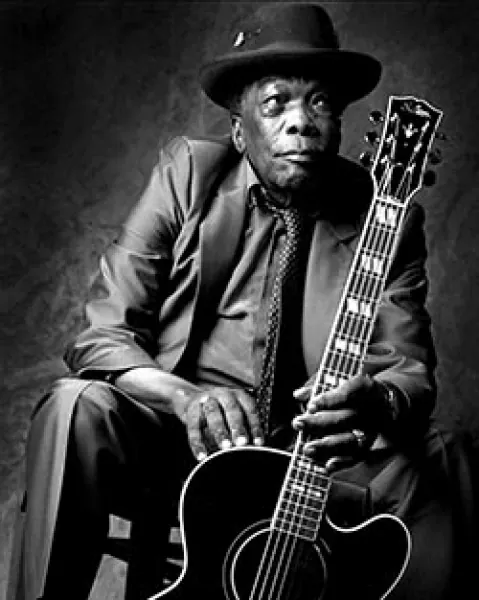
John Lee Hooker
Top John Lee Hooker albums
Top John Lee Hooker lyrics
(Twist Ain't Nothin') But the Old Time Shimmy *
John Lee HookerJohn Lee Hooker biography
John Lee Hooker (August 22, 1912[1] – June 21, 2001) was an American blues singer, songwriter, and guitarist. The son of a sharecropper, he rose to prominence performing an electric guitar-style adaptation of Delta blues. Hooker often incorporated other elements, including talking blues and early North Mississippi Hill country blues. He developed his own driving-rhythm boogie style, distinct from the 1930s–1940s piano-derived boogie-woogie. Some of his best known songs include "Boogie Chillen'" (1948), "Crawling King Snake" (1949), "Dimples" (1956), "Boom Boom" (1962), and "One Bourbon, One Scotch, One Beer" (1966). Several of his later albums, including The Healer (1989), Mr. Lucky (1991), Chill Out (1995), and Don't Look Back (1997) were album chart successes in the U.S. and U.K. Additionally, Don't Look Back won a Grammy Award in 1998. Early life[edit] Hooker's date of birth is the subject of debate.[2][5] He is believed to have been born in Tutwiler, Tallahatchie County, Mississippi, although some sources cite his birthplace as being near Clarksdale, Coahoma County,[6] the youngest of the eleven children of William Hooker (1871–after 1923),[7] a sharecropper and Baptist preacher, and Minnie Ramsey (circa 1880–date of d**h unknown).[8] The Hooker official website, however, indicates he was born on August 22, 1917.[citation needed] The Hooker children were home-schooled. Since they were only permitted to listen to religious songs, the spirituals sung in church were their earliest exposure to music. In 1921, his parents separated. The next year, his mother married William Moore, a blues singer who provided Hooker with his first introduction to the guitar (and whom John would later credit for his distinctive playing style).[9] Moore was his first significant blues influence. He was a local blues guitarist, who learned in Shreveport, Louisiana, to play a droning, one-chord blues that was strikingly different from the Delta blues of the time.[6] At the age of 14, John Lee Hooker ran away from home, reportedly never seeing his mother or stepfather again.[10] In the mid 1930s, Hooker lived in Memphis, Tennessee, where he worked on Beale Street at the New Daisy Theatre and occasionally performed at house parties.[6] He worked in factories in various cities during World War II, eventually landing a job in 1943 at the Ford Motor Company in Detroit. He frequented the blues clubs and bars on Hastings Street, the heart of the black entertainment district on Detroit's east side. In a city noted for its pianists, guitar players were scarce. Hooker's popularity grew quickly performing in Detroit clubs and, seeking a louder instrument than his acoustic guitar, he bought his first electric guitar.[11] Career[edit] Hooker playing Ma**ey Hall, Toronto. Photo: Jean-Luc Ourlin Hooker's recording career began in 1948, when Los Angeles-based Modern Records released a demo he had recorded for Bernie Besman in Detroit. The single, "Boogie Chillen'", became a hit and the biggest selling race record of 1949.[6] Despite being illiterate, Hooker was a prolific lyricist. In addition to adapting traditional blues lyrics, he also wrote originals. In the 1950s, many black musicians saw little money from their record sales. So Hooker often recorded variations on his songs for new studios for an upfront fee. To get around his recording contract, he used various pseudonyms, such as John Lee Booker, for Chess Records and Chance Records in 1951–1952; Johnny Lee for De Luxe Records in 1953–54; John Lee, John Lee Cooker,[12] Texas Slim, Delta John, Birmingham Sam and his Magic Guitar, Johnny Williams, and the Boogie Man.[13] His early solo songs were recorded by Bernie Besman. John Lee Hooker rarely played with a standard beat, instead, he changed tempo to fit the needs of the song. This often made it difficult to use backing musicians, who were not accustomed to Hooker's musical vagaries. As a result, Besman recorded Hooker, in addition to playing guitar and singing, stomping along with the music on a wooden pallet.[14] For much of this time period he recorded and toured with Eddie Kirkland. Later sessions for Vee-Jay Records in Chicago used studio musicians on most of his recordings, including Eddie Taylor, who could handle his musical idiosyncrasies. "Boom Boom" and "Dimples", two popular Hooker numbers, were originally released on Vee-Jay.[15] Later life[edit] Toronto, August 20, 1978 Hooker performed as a street musician in the 1980 film The Blues Brothers.[15] In 1989, he recorded the album The Healer with a number of guest musicians, including Carlos Santana and Bonnie Raitt.[15] Hooker recorded several songs with Van Morrison, including "Never Get Out of These Blues Alive", "The Healing Game", and "I Cover the Waterfront". He also appeared on stage with Van Morrison several times, some of which was released on the live album A Night in San Francisco. On December 19, 1989, Hooker performed "Boogie Chillen'" with the Rolling Stones and Eric Clapton in Atlantic City, New Jersey. As part of the Rolling Stones' Steel Wheels tour, the show was broadcast live on cable television on a pay-per-view basis. He lived the last years of his life in Long Beach, California. In 1997, he opened a nightclub in San Francisco's Fillmore District called John Lee Hooker's Boom Boom Room, after one of his hits.[15]
